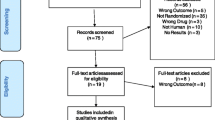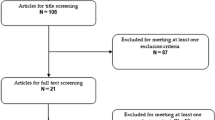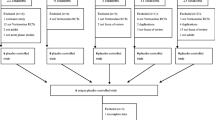Abstract
Background: Second-generation antidepressants dominate the management of patients with major depressive disorder (MDD). Evidence on the general and comparative benefits and harms is still accruing.
Objective: To systematically review the general and comparative efficacy and safety of duloxetine for the treatment of acute-phase MDD in adults.
Data Sources: We conducted a search of MEDLINE, Embase, PsychLit, The Cochrane Library, and the International Pharmaceutical Abstracts from 1980 to July 2009, as well as manually searching reference lists of pertinent review articles and exploring the Center for Drug Evaluation and Research database to identify unpublished research.
Study Selection: For efficacy, randomized controlled trials (RCTs) comparing duloxetine with placebo or second-generation antidepressants were included. For safety, both experimental and observational studies were eligible.
Data Extraction: Abstracts and full-text articles were independently reviewed by two people, one investigator extracted relevant data, and a senior reviewer checked data for completeness and accuracy.
Results: We included 36 experimental and observational studies and, where sufficient data were available, meta-analyses of RCTs were conducted. Findings indicated that duloxetine is an effective treatment option for acute-phase MDD, with a tolerability profile similar to other second-generation antidepressants. No substantial differences in efficacy and safety appear to exist when duloxetine is compared with other second-generation antidepressants. Overall, about 40% of patients treated with duloxetine achieved remission. Compared with other treatments, duloxetine had frequently higher rates of nausea, vomiting and dry mouth; however, these differences did not lead to higher discontinuation rates compared with selective serotonin reuptake inhibitors as a class. There is insufficient evidence to draw conclusions about rare but severe adverse events.
Conclusions: Current evidence does not warrant the choice of duloxetine over other second-generation antidepressants based on greater efficacy or safety for patients with acute-phase MDD with or without accompanying symptoms such as pain.
Similar content being viewed by others
References
Murray CJLLA, editor. The global burden of disease and injury series. Vol.1. A comprehensive assessment of mortality and disability from diseases, injuries, and risk factors in 1990 projected to 2020. Cambridge (MA): Harvard University Press, 1996
Kessler RC, Berglund P, Demler O, et al. Lifetime prevalence and age-of-onset distributions of DSM-IV disorders in the National Comorbidity Survey Replication. Arch Gen Psychiatry 2005 Jun; 62(6): 593–602
Greenberg PE, Kessler RC, Birnbaum HG, et al. The economic burden of depression in the United States: how did it change between 1990 and 2000? J Clin Psychiatry 2003 Dec; 64(12): 1465–75
American Psychiatric Association. Diagnostic and statistical manual of mental disorders. 4th ed., text revision. Washington, DC: American Psychiatric Association, 2000
Qaseem A, Snow V, Denberg TD, et al. Using second-generation antidepressants to treat depressive disorders: a clinical practice guideline from the American College of Physicians. Ann Intern Med 2008; 149(10): 725–33
Ellis P. Australian and New Zealand clinical practice guidelines for the treatment of depression. Aust N Z J Psychiatry 2004; 38(6): 389–407
Anderson IM, Ferrier IN, Baldwin RC, et al. Evidence-based guidelines for treating depressive disorders with anti-depressants: a revision of the 2000 British Association for Psychopharmacology guidelines. J Psychopharmacol 2008; 22(4): 343–96
Rush AJ, Trivedi MH, Wisniewski SR, et al. Acute and longer-term outcomes in depressed outpatients requiring one or several treatment steps: a STAR*D report. Am J Psychiatry 2006 Nov; 163(11): 1905–17
Gartlehner G, Hansen RA, Thieda P, et al. Comparative effectiveness of second-generation antidepressants in the pharmacologic treatment of adult depression. Comparative effectiveness review no. 7-EHC007-EF (prepared by RTI-UNC under contract no. 290-02-0016, TO #7.) Rockville (MD): Agency for Healthcare Research and Quality, 2007 [online]. http://effectivehealthcare.ahrq.gov [Accessed 2009 Sep 24]
Balk EM, Lau J, Bonis PA. Reading and critically appraising systematic reviews and meta-analyses: a short primer with a focus on hepatology. J Hepatol 2005; 43(4): 729–36
Harris RP, Helfand M, Woolf SH, et al. Current methods of the US Preventive Services Task Force: a review of the process. Am J Prev Med 2001 Apr; 20 (3 Suppl.): 21–35
Centre for Reviews and Dissemination. Undertaking systematic reviews of research on effectiveness: CRD’s guidance for those carrying out or commissioning reviews. CRD report Number 4 (2nd edition), 2001 [online]. Available from URL: http://www.york.ac.uk [Accessed 2008 Dec 2]
Deeks JJ, Dinnes J, D’Amico R, et al. Evaluating non-randomised intervention studies. Health Technol Assess 2003; 7(27): iii–ix, 1–173
Gartlehner G, Hansen RA, Nissman D, et al. A simple and valid tool distinguished efficacy from effectiveness studies. J Clin Epidemiol 2006; 60(7): 753–5
Hansen RA, Moore CG, Dusetzina SB, et al. Controlling for drug dose in systematic review and meta-analysis: a case study of the effect of antidepressant dose. Med Decis Making 2009 Jan 13; 29(1): 91–102
Gartlehner G, Gaynes BN, Hansen RA, et al. Comparative benefits and harms of second-generation antidepressants: background paper for the American College of Physicians. Ann Intern Med 2008; 149(10): 734–50
Detke MJ, Lu Y, Goldstein DJ, et al. Duloxetine 60mg once daily dosing versus placebo in the acute treatment of major depression. J Psychiatr Res 2002 Nov–Dec; 36(6): 383–90
Detke MJ, Lu Y, Goldstein DJ, et al. Duloxetine, 60 mg once daily, for major depressive disorder: a randomized double-blind placebo-controlled trial. J Clin Psychiatry 2002 Apr; 63(4): 308–15
Detke MJ, Wiltse CG, Mallinckrodt CH, et al. Duloxetine in the acute and long-term treatment of major depressive disorder: a placebo- and paroxetine-controlled trial. Eur Neuropsychopharmacol 2004 Dec; 14(6): 457–70
Goldstein DJ, Mallinckrodt C, Lu Y, et al. Duloxetine in the treatment of major depressive disorder: a double-blind clinical trial. J Clin Psychiatry 2002 Mar; 63(3): 225–31
Goldstein DJ, Lu Y, Detke MJ, et al. Duloxetine in the treatment of depression: a double-blind placebo-controlled comparison with paroxetine. J Clin Psychopharmacol 2004 Aug; 24(4): 389–99
Nemeroff CB, Schatzberg AF, Goldstein DJ, et al. Duloxetine for the treatment of major depressive disorder. Psychopharmacol Bull 2002; 36(4): 106–32
Perahia DG, Wang F, Mallinckrodt CH, et al. Duloxetine in the treatment of major depressive disorder: a placebo- and paroxetine-controlled trial. Eur Psychiatry 2006 Sep; 21(6): 367–78
Food and Drug Administration. Duloxetine prescribing information [online]. Available from URL: http://www.accessdata.fda.gov [Accessed 2009 Oct 8]
Thase ME, Pritchett YL, Ossanna MJ, et al. Efficacy of duloxetine and selective serotonin reuptake inhibitors: comparisons as assessed by remission rates in patients with major depressive disorder. J Clin Psychopharmacol 2007; 27(6): 672–6
Shelton RC, Andorn AC, Mallinckrodt CH, et al. Evidence for the efficacy of duloxetine in treating mild, moderate, and severe depression. Int Clin Psychopharmacol 2007 Nov; 22(6): 348–55
Brannan SK, Mallinckrodt CH, Brown EB, et al. Duloxetine 60 mg once-daily in the treatment of painful physical symptoms in patients with major depressive disorder. J Psychiatr Res 2005 Jan; 39(1): 43–53
Pigott TA, Prakash A, Arnold LM, et al. Duloxetine versus escitalopram and placebo: an 8-month, double-blind trial in patients with major depressive disorder. Curr Med Res Opin 2007 Jun; 23(6): 1303–18
Nierenberg AA, Greist JH, Mallinckrodt CH, et al. Duloxetine versus escitalopram and placebo in the treatment of patients with major depressive disorder: onset of anti-depressant action, a non-inferiority study. Curr Med Res Opin 2007 Feb; 23(2): 401–16
Perahia DG, Kajdasz DK, Walker DJ, et al. Duloxetine 60 mg once daily in the treatment of milder major depressive disorder. Int J Clin Pract 2006; 5: 613–20
Lindstrom E, Lewander T, Malm U, et al. Patient-rated versus clinician-rated side effects of drug treatment in schizophrenia: clinical validation of a self-rating version of the UKU Side Effect Rating Scale (UKU-SERS-Pat). Nord J Psychiatry 2001; 55 Suppl. 44: 5–69
Food and Drug Administration. Guideline for industry. Clinical safety data management: definitions and standards for expedited reporting [online]. Available from URL: http://www.fda.gov [Accessed 2008 Feb 2]
Gartlehner G, Thieda P, Hansen RA, et al. Comparative risk for harms of second-generation antidepressants: a systematic review and meta-analysis. Drug Saf 2008; 31(10): 851–65
Raskin J, Goldstein DJ, Mallinckrodt CH, et al. Duloxetine in the long-term treatment of major depressive disorder. J Clin Psychiatry 2003 Oct; 64(10): 1237–44
Acharya N, Rosen AS, Polzer JP, et al. Duloxetine: meta-analyses of suicidal behaviors and ideation in clinical trials for major depressive disorder. J Clin Psychopharmacol 2006; 26(6): 587–94
Montejo AL, Llorca G, Izquierdo JA, et al. Incidence of sexual dysfunction associated with antidepressant agents: a prospective multicenter study of 1022 outpatients. Spanish Working Group for the Study of Psychotropic-Related Sexual Dysfunction. J Clin Psychiatry 2001; 62 Suppl. 3: 10–21
Hudson JI, Wohlreich MM, Kajdasz DK, et al. Safety and tolerability of duloxetine in the treatment of major depressive disorder: analysis of pooled data from eight placebo-controlled clinical trials. Human Psychopharmacol 2005; 20(5): 327–41
Food and Drug Administration. FDA alert 07/2006: potentially life-threatening serotonin syndrome with combined use of SSRIs or SNRIs and triptans medications, 2006 [online]. Available from URL: http://www.fda.gov [Accessed 2009 Jan 13]
Food and Drug Administration. Duloxetine statistical reviews [online]. Available from URL: http://www.accessdata.fda.gov [Accessed 2008 Dec 30]
Dunner DL, Wilson M, Fava M, et al. Long-term tolerability and effectiveness of duloxetine in the treatment of major depressive disorder. Depress Anxiety 2008; 25(5): E1–8
Wernicke J, Lledo A, Raskin J, et al. An evaluation of the cardiovascular safety profile of duloxetine: findings from 42 placebo-controlled studies. Drug Saf 2007; 30(5): 437–55
Thase ME, Tran PV, Wiltse C, et al. Cardiovascular profile of duloxetine, a dual reuptake inhibitor of serotonin and norepinephrine. J Clin Psychopharmacol 2005 Apr; 25(2): 132–40
Khan A, Bose A, Alexopoulos GS, et al. Double-blind comparison of escitalopram and duloxetine in the acute treatment of major depressive disorder. Clin Drug Investig 2007; 27(7): 481–92
Wade A, Gembert K, Florea I. A comparative study of the efficacy of acute and continuation treatment with escitalopram versus duloxetine in patients with major depressive disorder. Curr Med Res Opin 2007 Jul; 23(7): 1605–14
Lee P, Shu L, Xu X, et al. Once-daily duloxetine 60 mg in the treatment of major depressive disorder: multicenter, double-blind, randomized, paroxetine-controlled, non-inferiority trial in China, Korea, Taiwan and Brazil. Psychiatry Clin Neurosci 2007 Jun; 61(3): 295–307
Perahia DG, Pritchett YL, Kajdasz DK, et al. A randomized, double-blind comparison of duloxetine and venla-faxine in the treatment of patients with major depressive disorder. J Psychiatr Res 2008 Jan; 42(1): 22–34
Cookson J, Gilaberte I, Desaiah D, et al. Treatment benefits of duloxetine in major depressive disorder as assessed by number needed to treat. Int Clin Psychopharmacol 2006; 21(5): 267–73
Mallinckrodt CH, Prakash A, Houston JP, et al. Differential antidepressant symptom efficacy: placebo-controlled comparisons of duloxetine and SSRIs (fluoxetine, paroxetine, escitalopram). Neuropsychobiology 2007; 56(2–3): 73–85
Greist J, McNamara RK, Mallinckrodt CH, et al. Incidence and duration of antidepressant-induced nausea: duloxetine compared with paroxetine and fluoxetine. Clin Ther 2004 Sep; 26(9): 1446–55
Clayton A, Kornstein S, Prakash A, et al. Changes in sexual functioning associated with duloxetine, escitalopram, and placebo in the treatment of patients with major depressive disorder. J Sex Med 2007 Jul; 4 (4 Pt 1): 917–29
Delgado PL, Brannan SK, Mallinckrodt CH, et al. Sexual functioning assessed in 4 double-blind placebo- and paroxetine-controlled trials of duloxetine for major depressive disorder. J Clin Psychiatry 2005 Jun; 66(6): 686–92
Anderson IM, Tomenson BM. Treatment discontinuation with selective serotonin reuptake inhibitors compared with tricyclic antidepressants: a meta-analysis. BMJ 1995 1995 Jun 3; 310(6992): 1433–8
Montgomery SA, Henry J, McDonald G, et al. Selective serotonin reuptake inhibitors: meta-analysis of discontinuation rates. Int Clin Psychopharmacol 1994; 9: 47–53
Krebs EE, Gaynes BN, Gartlehner G, et al. Treating the physical symptoms of depression with second-generation antidepressants: a systematic review and metaanalysis. Psychosomatics 2008; 49(3): 191–8
Brecht S, Courtecuisse C, Debieuvre C, et al. Efficacy and safety of duloxetine 60 mg once daily in the treatment of pain in patients with major depressive disorder and at least moderate pain of unknown etiology: a randomized controlled trial. J Clin Psychiatry 2007 Nov; 68(11): 1707–16
Raskin J, Wiltse CG, Siegal A, et al. Efficacy of duloxetine on cognition, depression, and pain in elderly patients with major depressive disorder: an 8-week, double-blind, placebo-controlled trial. Am J Psychiatry 2007 Jun; 164(6): 900–9
Burt VK, Wohlreich MM, Mallinckrodt CH, et al. Duloxetine for the treatment of major depressive disorder in women ages 40 to 55 years. Psychosomatics 2005 Jul–Aug; 46(4): 345–54
Raskin J, Wiltse CG, Dinkel JJ, et al. Safety and tolerability of duloxetine at 60 mg once daily in elderly patients with major depressive disorder. J Clin Psychopharmacol 2008 Feb; 28(1): 32–8
Russell J, Raskin J, Wiltse C, et al. Efficacy and tolerability of duloxetine treatment in elderly patients with major depressive disorder and concurrent anxiety symptoms. Psychiatry 2007; 4(6): 33–45
Nelson JC, Wohlreich MM, Mallinckrodt CH, et al. Duloxetine for the treatment of major depressive disorder in older patients. Am J Geriatr Psychiatry 2005 Mar; 13(3): 227–35
Wohlreich MM, Mallinckrodt CH, Watkin JG, et al. Duloxetine for the long-term treatment of major depressive disorder in patients aged 65 and older: an open-label study. BMC Geriatr 2004 Dec 7; 4: 11
Wise TN, Wiltse CG, Iosifescu DV, et al. The safety and tolerability of duloxetine in depressed elderly patients with and without medical comorbidity. Int J Clin Pract 2007 Aug; 61(8): 1283–93
Lewis-Fernandez R, Blanco C, Mallinckrodt CH, et al. Duloxetine in the treatment of major depressive disorder: comparisons of safety and efficacy in U.S. Hispanic and majority Caucasian patients. J Clin Psychiatry 2006; 67(9): 1379–90
Bailey RK, Mallinckrodt CH, Wohlreich MM, et al. Duloxetine in the treatment of major depressive disorder: comparisons of safety and efficacy. J Natl Med Assoc 2006; 98(3): 437–47
Stewart DE, Wohlreich MM, Mallinckrodt CH, et al. Duloxetine in the treatment of major depressive disorder: comparisons of safety and tolerability in male and female patients. J Affect Disord 2006; 94(1–3): 183–9
Cipriani A, Furukawa TA, Salanti G, et al. Comparative efficacy and acceptability of 12 new-generation anti-depressants: a multiple-treatments meta-analysis. Lancet 2009 Feb 28; 373(9665): 746–58
Gartlehner G, Hansen RA. Are some antidepressants better than others? Nat Rev Neurol 2009 May; 5(5): 239–40
Mallinckrodt CH, Goldstein DJ, Detke MJ, et al. Duloxetine: new treatment for the emotional and physical symptoms of depression. Prim Care Companion J Clin Psychiatry 2003 Feb; 5(1): 19–28
Kirsch I, Deacon BJ, Huedo-Medina TB, et al. Initial severity and antidepressant benefits: a meta-analysis of data submitted to the Food and Drug Administration. PLoS Med 2008 Feb; 5(2): e45
Author information
Authors and Affiliations
Corresponding author
Electronic supplementary material
Rights and permissions
About this article
Cite this article
Gartlehner, G., Thaler, K., Hansen, R.A. et al. The General and Comparative Efficacy and Safety of Duloxetine in Major Depressive Disorder. Drug-Safety 32, 1159–1173 (2009). https://doi.org/10.2165/11318930-000000000-00000
Published:
Issue Date:
DOI: https://doi.org/10.2165/11318930-000000000-00000




